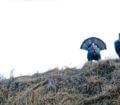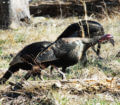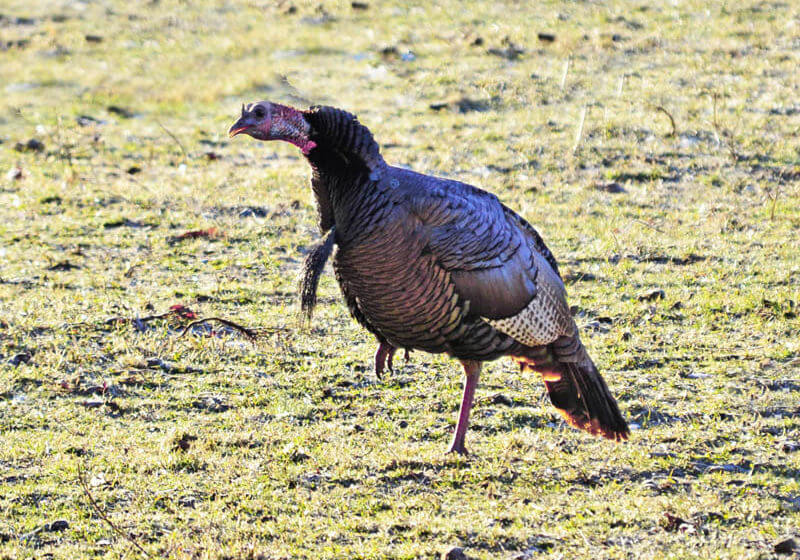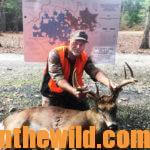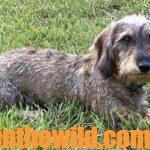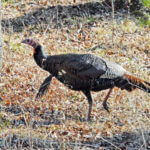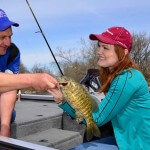Editor’s Note: David Hale of Cadiz, Kentucky, started his turkey-hunting career in 1966. He’s a co-founder of Knight & Hale Game Calls (http://www.knightandhale.com) and Commonwealth Productions and cohosts the “Ultimate Hunting” TV show (http://outdoorchannel.com/ultimate-hunting) on the Outdoor Channel.
Back when I was hunting in the Land Between the Lakes (http://www.landbetweenthelakes.us), which is a public-hunting area, if there were 1-15 turkeys harvested during the entire turkey season that would have been declared a great year for turkey hunting. Everyone else had left the woods on this particular day when at 12:00 noon, I heard two turkeys gobble and went to them. As I drew closer to the birds, both longbeards would gobble, but I also noticed they would run toward each other. I had both turkeys coming to me, and I was excited, since I felt certain I’d bag one of those longbeards.
 However, I’ve learned since then that there’s no such thing as being able to bag a tom just because you hear a turkey coming to you. As the two birds came in, they walked on either side of the tree where I was sitting – both out of range. Once they got past me, they started fighting with each other about 100 yards from me. I was using my binoculars. I got mad with myself, and I told myself, “You’ve been hunting all morning long, you’ve had two chances to bag a gobbler on public ground, and now you’re not going to get a shot.” I was frustrated with myself, but then for no reason at all, those two turkeys quit fighting and started running straight to me – one turkey chasing the other through open woods. I studied their beards to see which gobbler had the longest beard and saw that it was the second bird. So, I let the first bird run past me – well within shooting distance – only about 10 yards away. The second bird, which had the longest beard, was moving so fast I missed him.
However, I’ve learned since then that there’s no such thing as being able to bag a tom just because you hear a turkey coming to you. As the two birds came in, they walked on either side of the tree where I was sitting – both out of range. Once they got past me, they started fighting with each other about 100 yards from me. I was using my binoculars. I got mad with myself, and I told myself, “You’ve been hunting all morning long, you’ve had two chances to bag a gobbler on public ground, and now you’re not going to get a shot.” I was frustrated with myself, but then for no reason at all, those two turkeys quit fighting and started running straight to me – one turkey chasing the other through open woods. I studied their beards to see which gobbler had the longest beard and saw that it was the second bird. So, I let the first bird run past me – well within shooting distance – only about 10 yards away. The second bird, which had the longest beard, was moving so fast I missed him.
So, I had one of the greatest hunts of my life and one of the greatest hunts I ever had at Land Between the Lakes. I had had two chances to take a longbeard, and because I wasn’t satisfied with just taking a gobbler, I had let the lead bird run past me and didn’t take a shot. Although my ego demanded that I wait for the bird with the longer beard, I didn’t get him either. As I walked out of the woods, I said to myself, “I won’t make that mistake again! If a longbeard comes within gun range, and I have the opportunity to take him, I’ll take the closest bird that comes in and give that bird a free ride home.”
I’ve learned that one of the easiest ways to bag a gobbler on public land is to go hunting for turkeys on days when most hunters won’t go hunting like rainy days, when one of those freaky snow events occurs and/or on those days when the wind’s howling, and you hardly can hear yourself think. I’ve discovered that I’ve found and can take turkeys easier and quicker with little or no competition for the gobblers on those bad days than I can on good days, especially on public lands.
Occasionally we’ll have snow during turkey season here in Kentucky where I live. I’ll go to the woods to hunt turkeys then, and I’ve discovered that at least here in Kentucky, the turkeys gobble better in a snow than they do on those pretty, bluebird days. I’ve also learned when the wind’s howling, and I call to turkeys, they’ll answer me or come in silent. On a windy day, gobblers only will hear a piece of your calling sequence. But they still want to find and breed a hen as quickly as possible to keep from losing her to other gobblers.
 However, one of the strangest hunts I’ve ever been on and one I probably learned the most from, took place when I was taking a customer who bought Knight & Hale turkey calls from our company on a turkey hunt. I knew where there was a turkey that would call every time I yelped to him. He’d come in where I could see him, circle around me, get behind me and then leave. On the day I took the buyer with me, when the turkey gobbled, I called to him. When I heard him coming, the buyer and I got up quickly and moved back behind the tree we’d called from and waited on Roho – what we’d named the bird. Sure enough the turkey came in, and the buyer bagged the gobbler. I told the buyer that he had killed Roho, a bird I’d been trying to take since the beginning of turkey season.
However, one of the strangest hunts I’ve ever been on and one I probably learned the most from, took place when I was taking a customer who bought Knight & Hale turkey calls from our company on a turkey hunt. I knew where there was a turkey that would call every time I yelped to him. He’d come in where I could see him, circle around me, get behind me and then leave. On the day I took the buyer with me, when the turkey gobbled, I called to him. When I heard him coming, the buyer and I got up quickly and moved back behind the tree we’d called from and waited on Roho – what we’d named the bird. Sure enough the turkey came in, and the buyer bagged the gobbler. I told the buyer that he had killed Roho, a bird I’d been trying to take since the beginning of turkey season.
A few days later I had another buyer come in, and I decided that we’d start hunting where we’d heard Roho. Although I felt sure there was only one gobbler (Roho) gobbling in that area, when I started calling, I heard Roho calling. That turkey came in and got close to us, and the turkey went around me, so I knew it had to be Roho. So I hunted two days with the buyer, and on the third day, I called to Roho. The buyer and I moved back behind the tree I’d been calling from, and sure enough Roho showed-up, and the buyer shot him. A few days later I was taking another buyer hunting, and I said, “Let’s go to a place where I’ve already taken two birds and see if there’s another longbeard in there.” I began calling, a turkey answered me, and we took that turkey. A few days later we went back to the same spot, started calling and again Roho answered. But we didn’t take Roho on that day.
 What I finally figured out was that Roho was the dominant gobbler in that area. The other gobblers we’d been taking were 2- and 3-year old gobblers that would try to get to the hen (my calling) before Roho arrived. I noticed that all three of the gobblers we’d taken had come in silent and come in behind us, just like Roho would. Every time we killed a turkey out of that spot, we thought we’d bagged Roho. I finally realized that those subordinate gobblers would circle and come in behind us silently, so if Roho was coming to that call, they’d be able to see him before he spotted them. Apparently they knew that if Roho saw them going to one of his hens, he’d beat them up. If they spotted Roho, they could leave without getting into a fight. If they didn’t see Roho, they had an opportunity to get to the hen before he got to her.
What I finally figured out was that Roho was the dominant gobbler in that area. The other gobblers we’d been taking were 2- and 3-year old gobblers that would try to get to the hen (my calling) before Roho arrived. I noticed that all three of the gobblers we’d taken had come in silent and come in behind us, just like Roho would. Every time we killed a turkey out of that spot, we thought we’d bagged Roho. I finally realized that those subordinate gobblers would circle and come in behind us silently, so if Roho was coming to that call, they’d be able to see him before he spotted them. Apparently they knew that if Roho saw them going to one of his hens, he’d beat them up. If they spotted Roho, they could leave without getting into a fight. If they didn’t see Roho, they had an opportunity to get to the hen before he got to her.
Finally on the last day of the season, I decided I was going to take Roho. I went to the same spot where I’d been calling to him earlier in the season. He answered me from the same tree from where he’d always answered me. I went to the same spot where I’d gone to, and where we’d harvested those subordinate gobblers. I never made a sound, the real Roho showed-up, and I bagged him.
From Roho, I’ve learned to always return to a place where I’ve bagged a turkey before. You’ll never know how many gobblers are in an area, and you may have an opportunity to take several gobblers out of that location before the season ends.
To learn more about hunting turkeys, check out John E. Phillips’ eBooks and print and Audible books at https://johninthewild.com/books. You also can download a free Kindle app that enables you to read the book on your iPad, computer or SmartPhone.
For a free copy of John E. Phillips’ “The Turkey Gobbler Getter Manual,” go to https://johninthewild.com/free-books/ to download.

